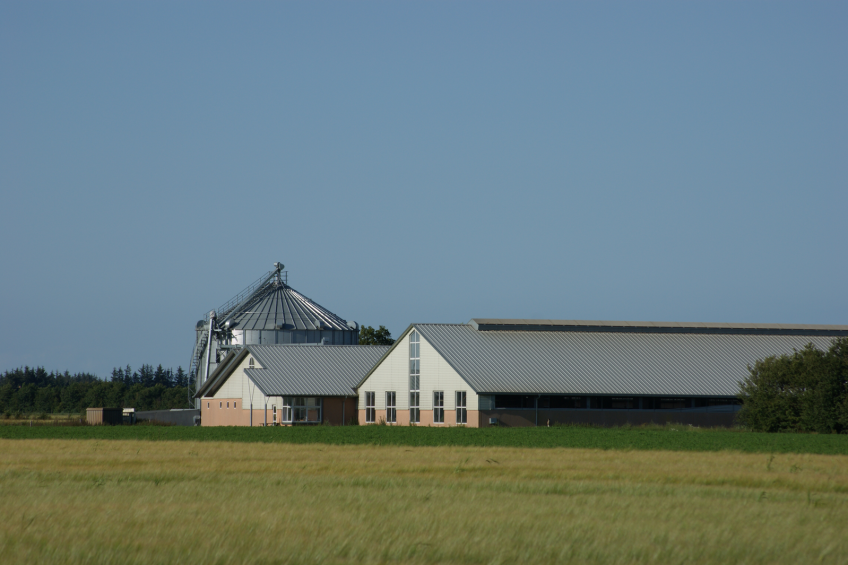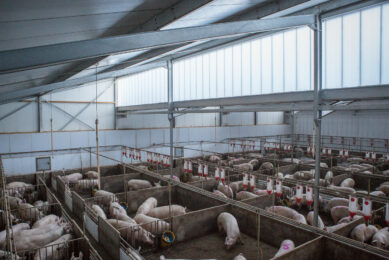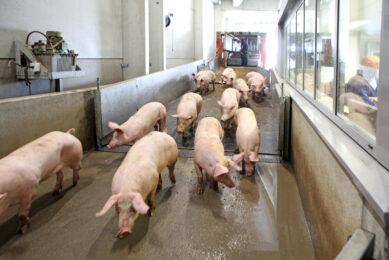Look out for the iron gap

Anaemia in piglets as a result of iron deficiency was thought to be something of the past by supplying iron in the piglets’ first week. In modern production, however, anaemia is back, affecting welfare and profits. It’s time to re-open the case.
By Anne Mette Strunz Hanl, DVM, Ø-Vet A/S, Denmark
Anaemia in piglets is a condition characterised by a lack of iron-carrying haemoglobin in the red blood cells. In effect, this means that the vital oxygen-carrying capacity from the lungs to the tissues of the body and the reverse transportation of carbon dioxide from the cellular metabolism back to the lungs is greatly reduced as the piglet is incapable of synthesising an adequate amount of haemoglobin. Very often, this condition is a result of iron deficiency, and it occurs when the piglet’s own iron stores are depleted or when the exposure to stress conditions either inhibits the build-up of haemoglobin or increases the degradation of haemoglobin in the piglet. The condition has different stages, but it develops rapidly and, if left unattended, a reversible sub-clinical condition of anaemia will quickly turn into an acute condition of full-scale iron deficiency-induced anaemia.
Well-known Prof Robert Friendship, Ontario Veterinary College, University of Guelph, Canada, has been working internationally for a long time to increase the understanding of iron deficiency anaemia. He comments, “That anaemia in piglets poses a serious threat to both animal welfare and profits and is not new to swine producers. The problem is that many go about in the mistaken belief that the risk of anaemia has been eliminated with the administration of 200 mg supplemental iron to the piglets when, in reality, what we see is that the increased productivity of modern swine production has caused increased iron needs.”
A new increased risk
Modern swine production has led to an impressive increase in productivity, but the development comes at a price as it has created a potential iron gap that can be easily missed if not looked for. The new increased risk of iron deficiency-induced anaemia is caused by several factors:
- Increased litter sizes resulting in lower iron stores at birth
- Increased spread in birth weights and growth rates as a direct consequence
- Accelerated growth rates for piglets born with above-average birth weights result in increased risk of depletion of available iron stores
- Low levels of iron in the sow’s milk are diminished to even lower levels with the increased litter sizes.
Prof Friendship says, “In effect, this means that the fastest growing piglets are the ones most at risk of developing iron deficiency-induced anaemia. The fast growers are often on an all-milk diet which offers a good source of all nutrients required by the piglet, except for iron. Weight gain on an all-milk diet is, therefore, associated with an increased risk of developing sub-clinical iron deficiency, which could eventually lead to iron deficiency-induced anaemia.”
Early stage detection is key
Detecting iron deficiency at an early stage is essential. A critical phase in the development of sub-clinical iron deficiency anaemia is the seven to ten-day period immediately prior to weaning. At this particular time of the growth phase, the above-average weight piglets on an all-milk diet are subject to development of sub-clinical iron deficiency. At this stage, the initial dose of supplemental iron has been assimilated and incorporated into blood haemoglobin, body organs and tissues, and a state of iron depletion must therefore be monitored for, see Figure 1.
Haemoglobin treshold values forsubclinical and clinical anaemia
It is generally accepted that blood haemoglobin concentrations below 90 g/l in piglets at weaning may be used to define cases of iron deficiency-induced anaemia, and that an optimal haemoglobin blood concentration may be defined as 110 g/l. Recent prevalence studies from the US, Denmark, Canada and Norway have demonstrated a prevalence of iron deficiency-induced anaemia with a haemoglobin concentration below 90 g/l of around 20% in a general commercial setting. Up to 75% have been found to have an inadequate level of iron when using the threshold of 110 g Hb/l as the optimal value.
The reversed picture
Interestingly, iron depletion is predominantly seen in above average weight piglets, meaning the fastest growing and, thus, most profitable piglets are the ones most prone to developing iron deficiency-induced anaemia.
Friendship says, “The high prevalence of early or late stage iron deficiency-induced anaemia found in the herds studied demonstrates the unrecognised risk of anaemia in modern swine production.
It is only natural to intuitively look at the smallest and, seemingly, weaker piglets in the herd when evaluating the general health status, but when it comes to iron deficiency-induced anaemia, it is often the other way around.”
Blindfolded risk management
Iron deficiency can be described as a hidden condition that may thrive and cause irreversible damage to a herd before it is finally detected. The risk associated with not regularly monitoring for iron deficiency is therefore of devastating proportions to the individual swine producer. And for no reason at all. With the HemoCue 201+ Point of Care Analyzer a simple blood sample from the piglet’s ear will show the level of haemoglobin within 30 seconds and thereby tell if the piglet is at risk of developing iron deficiency.
Friendship adds, “Anaemia is difficult to see with the naked eye – even to the trained observer. Few facilities have adopted a strategy for monitoring for iron deficiency which means that the current management of anaemia is handled blindfolded.
With the single dose administration at day 1 to 3, many are led to believe that they are in fact managing a potential risk when in reality iron stores may be depleted and a case of anaemia about to develop.”
Turning risk into advantage
Traditional attempts to replenish iron stores by means of supplemental oral iron have demonstrated limited effect due to failed absorption of the ferrous sulfate by the immature gut of the piglets, as was reported by S.L. Hansen and others, in 2010. Most studies suggest that administration of injectable iron is the most effective preventative measure for iron deficiency-induced anaemia in piglets. At the same time it is the only treatment available for targeted treatment of acute state anaemic piglets.
The remarkable development in modern swine production is a success story with piglets displaying incredible growth rates in their first few weeks of life. This development in pig production has a built in bottleneck, which is the new – albeit manageable – iron gap. If renewed attention is paid to the potential risk factors, and the additional need for iron supplementation is incorporated in the risk management of modern practices, anaemia can once again be yesterday’s problem with better animal welfare and improved profitability as an added value.
Detecting and treating anaemia
Iron deficiency can be diagnosed through a blood sample. As the early stage of the condition is readily reversible to normal levels of blood haemoglobin with the administration of additional injectable iron supplementation, it is essential that the condition is detected before it develops into full-scale iron deficiency-induced anaemia. The return to normal haemoglobin levels for piglets with acute anaemia can be accomplished by the administration of injectable iron supplementation.
However, avoiding the acute stage anaemia is desirable as the recovery period is significantly longer and directly associated with a loss of production. Leading pharmaceutical manufacturers of iron injection have recently introduced hands-on anaemia point of care programmes that include measurement of haemoglobin values right before weaning, using a HemoCue 201+ device.
[Source: Pig Progress special – Piglet Health, 2014]










